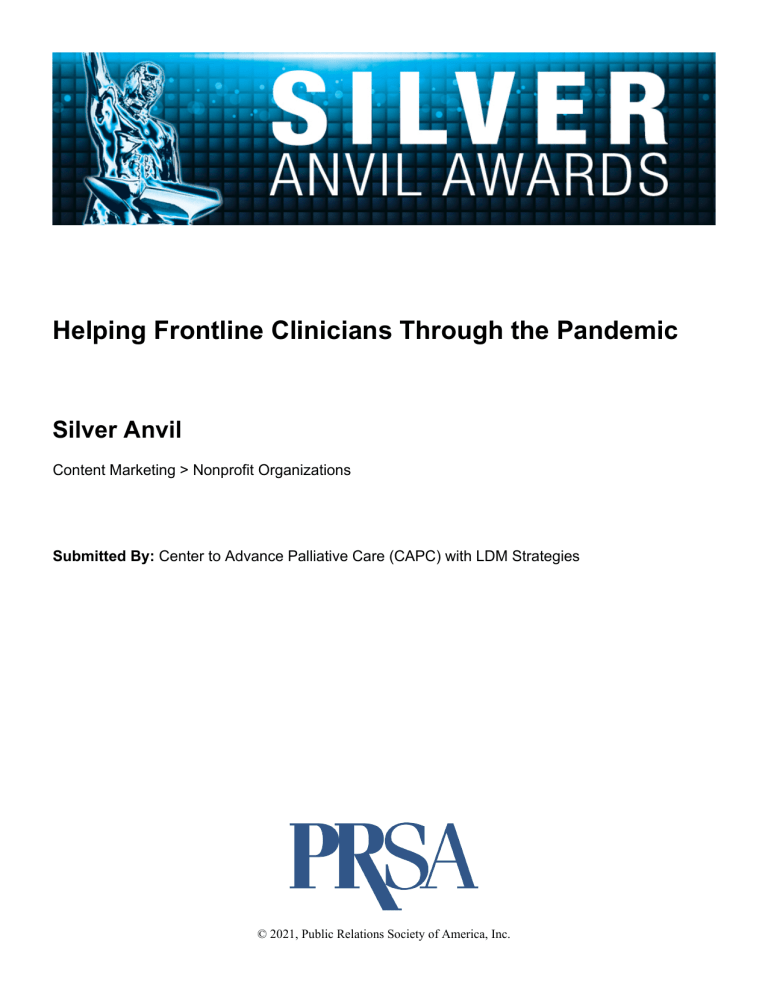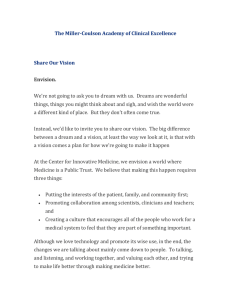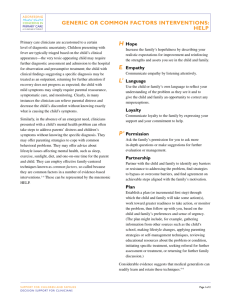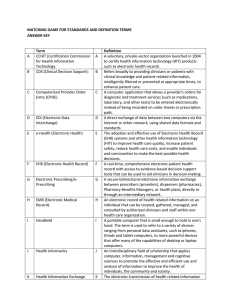
Helping Frontline Clinicians Through the Pandemic Silver Anvil Content Marketing > Nonprofit Organizations Submitted By: Center to Advance Palliative Care (CAPC) with LDM Strategies © 2021, Public Relations Society of America, Inc. Title: Helping Frontline Clinicians through the Pandemic Submission Category: Content Marketing Submitted by: Center to Advance Palliative Care and LDM Strategies Situation On March 13, 2020, the U.S. shut down due to the deadly COVID-19 (“Covid”) pandemic. People’s greatest fear was dying or becoming overwhelmed by enormous physical suffering. Was the health care system ready to respond, quickly and effectively, when patients needed relief of symptoms like severe, uncontrolled shortness of breath? Were clinicians caring for Covid-positive patients ready to communicate with family (and other caregivers), when they could not visit their loved ones in the hospital? Despite the importance of these conversations, many physicians did not feel prepared to take on discussions of this type, as they were never trained to do so. The principles and practices of palliative care—relief of complex symptoms due to serious illness, communication with family and all other clinicians, support for priority setting—were the same skills needed to navigate the influx of patients who were sick due to the virus. However, palliative care teams were a scarce resource. While they themselves needed strategic support to make rapid decisions on the wards, it was necessary to scale this knowledge and skill to all clinicians treating people with Covid. To address this need, the Center to Advance Palliative Care (CAPC) provided essential online tools and support for clinicians from all disciplines and all specialties, free of charge, throughout the pandemic. Insights and Analysis In addition to hearing directly from clinicians on the front lines, we relied on data, which showed critical gaps in care. CAPC’s most recent Report Card data show that palliative care teams are not available in every U.S. hospital—while 94% of U.S. hospitals with more than 300 beds have a team, only 62% of hospitals with 50 to 299 beds have a team. Additionally, just 29% of physicians report having any formal training in communication about goals of care, and 46% report they are unsure about what to say in these conversations. With communication between clinicians, patients, and families being a major issue during Covid, there was a clear need and demand for complex communication and symptom management skills—the domain of palliative care. This was reinforced by clinicians reaching out to CAPC, asking for help. Additionally, numerous articles were highlighting clinician burnout and distress due to struggles with family communication. Planning We were faced with the challenge of reaching and engaging clinicians working on the front lines, who had no time to breathe let alone train. Getting CAPC’s tools and technical assistance into the hands of as many clinicians as possible, in an immediate, accessible, and useful way, required a mix of integrated strategies, including: (1) Ensuring that hospital stakeholders nationwide knew about the CAPC COVID-19 Rapid Response Resources Hub (“Hub”) and how to access it online, within 48 hours of the U.S. lockdown; (2) Publicizing and promoting the Hub through briefings by leading experts, media relations, social media, highly-targeted email communications, SEO/SEM, digital advertising, and original editorial content from health care leaders and clinicians on the front lines; (3) Developing the original Hub content into a branded mobile-optimized microsite that functioned like an app in the pockets of all clinicians on Covid wards (e.g., ED, ICU); and (4) Increasing awareness of the value of palliative care within the hospital. Copyright 2021, Public Relations Society of America, Inc. Execution With a focus on timing and a steady drumbeat of cross-channel communication, program tactics were centered on: term “COVID-19” in the advertising, due to new advertising rules set by Google. Evaluation With the goal of supporting palliative care teams Microsite: At the start of the surge we quickly with just-in-time resources, geared to Covid, while also scaling knowledge and skill to other developed, designed, and built an app-like clinicians not normally trained in this area, we microsite (the “Hub”), where all Covidbecame a go-to resource for hospitals and health related content was moved for a better user experience: capc.org/covid-19. The microsite, systems across the country. From March through December 2020, the Hub microsite and its which had over 150+ resources, helped accompanying elements achieved: clinicians on the front lines immediately access just-in-time tools at the bedside, no matter their device. The Hub could be easily Objective: To drive and increase awareness and updated as additional needs were captured adoption of the Hub among clinicians on the front (via word of mouth, online form, and articles lines through content marketing, social media in the press), and resources were built or multi-channel marketing, and media relations. identified. National Briefings: We organized, scheduled, and held a national briefing to announce the launch of the Hub on March 16, 2020. This was followed by a second briefing, which was hosted in partnership with the American Hospital Association (AHA). Having AHA as a partner expanded our reach to an additional audience of hospital-based clinicians, eager to access the free resources. Stakeholder engagement: Using a multichannel approach, including highlytargeted emails to over 90,000 clinicians, we successfully engaged a target audience that was exhausted and stressed. Our social media strategy (Twitter, LinkedIn, and Facebook) was re-prioritized to drive traffic to the Hub and related virtual events. And the blog strategy was reimagined with original essential content, including health equity, burnout, and emotional PPE. Additionally, we created and promoted Virtual Office Hours so that all clinicians could ask experts and peers their urgent questions. Digital marketing: To encourage more clinicians to visit the Hub, we advertised via Google Ads; though effective, there was the added challenge of not being able to use the Results: Social media proved to be a critical tactic with high engagement. On Twitter, we had 3,100+ tweets, reaching 17,000+ clinicians and health care leaders, and garnering an engagement rate of 25,800+; on LinkedIn there was a 44% increase in clicks; and on Facebook, there was a 51% increase in engagement. The 9 Covid-specific blog posts garnered 30,000+ page views, a 74% increase in readership from 2019. And our media efforts resulted in 276 placements, reaching an audience of over 187 million. Press coverage included CAPC Director, Dr. Diane Meier’s Brief But Spectacular video for PBS NewsHour, articles in The Wall Street Journal and USA Today, and more. As of December 2020, the Hub received over 215,000 page views and 150,000 resource downloads, with an average time on site being about 6 minutes. Google ads achieved a 4.05% click thru rate. As of December 2020, 175,000+ Hub clinical training courses have been completed, a record for CAPC. Page views increased 20% between June and December 2020. There has been a 150% increase in attendance for the Hub-related Virtual Office Hours, and the two national briefings resulted in 2,000 registrations and an additional 14,000 on-demand views. Copyright 2021, Public Relations Society of America, Inc.



